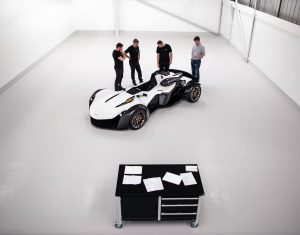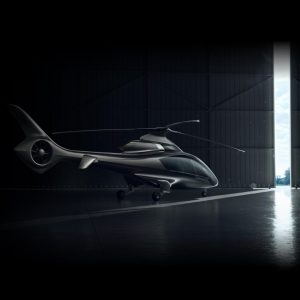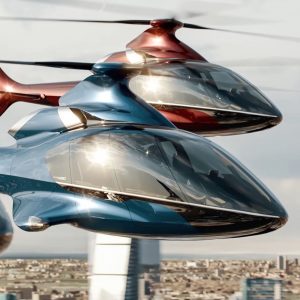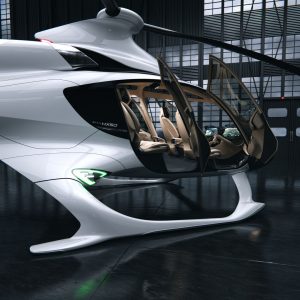In this episode of the 360 interviews, we have decided to chat with Henry Morshead- Chief Designer at Hill Helicopters
How did you end up where you are – what’s your career path been?
The central thread in my career, since childhood really, is that technology and creativity thrive together. But I’ve also spent a lifetime in studios where Design and Engineering close their minds to each other, and to those who bridge the gap. After an apprenticeship at Westland, I did Aeronautical Engineering followed by the RCA Vehicle Design course. Unfortunately in the ’90s, Automotive was in recession and Aerospace wasn’t really ready for design, so I did a couple of tours of Bosnia followed by several years as a 4×4 mechanic. It was an odd start for a designer, but a fantastic grounding in the real world, which didn’t orbit a single brand or studio. Along the way, I sketched every day and learned Alias and ICEMSurf for a living.
I got into the car studios through 3D modelling, but it was completely the wrong environment for cross-discipline creativity. You have to be one thing only, and stick to it – square peg, square hole. One day I did a VR course and got talking about aerospace. At about the same time, Jason Hill (Hill Helicopters) did the course, asking about design. Nick John at Symetri had taught us both – when he put us together, the interview only finished when the pub shut. A couple of weeks later, I was sketching the first lines of HX50 as Chief Designer. It’s the best job ever – fast, innovative and a fantastic example of the synergy that design and tech can deliver when you take off the shackles.

How have you seen software and tech change over the past ten years?
It’s clear that both the software and hardware have become more accessible. At the RCA, two of my colleagues got to learn CDRS. They spent almost every day getting those Silicon Graphics ‘filing cabinets’ to bend a curve, and perhaps designed less for it. So the big change is that today, one doesn’t have to choose between being a technician or a creative. Get a laptop, and a coffee, and do both.

How have you developed your design style throughout your career journey?
The founding principle came from my (non-designer) parents – observe, appreciate but don’t judge. Don’t just react, but respond, with structure, ready for communication. Keep an open mind and remember it all comes back to people – even when a good idea is pulling you away. In terms of process, I’d always been able to spin shapes in my mind, to the extent of having a second career in cutaway art. But with modern tech, I can freeze and save those spinning shapes, to analyse or branch into variants in a structured way. This gives creative confidence to take the broadest view of a problem, and also perhaps a step back from a predictable ‘house style’.
What are your thoughts on the importance of seeding tech and training at an educational level both in university and for the manufacturers?
This is incredibly important – we have to arm creative diversity with the right tools, as early and widely as possible. As a student, albeit before the internet and email, my biggest frustration was the lack of engagement or compatibility with the industry. We all had energy and ideas but no idea if we were on the right track, which did a lot of damage. Looking back now, from industry into universities, the only certainty is that hiring grads without a core handshake (like tech) is slow and risky. Seeding tech early gives students a knowledge structure to build on and gives them the confidence to invest time and effort. Manufacturers can set real-world challenges, and universities can tune their output to what employers (or freelancers’ clients) actually need.

The Automotive / Transport visualisation process is now more than ever in the spotlight of design development – how have you seen this change over the past few years?
The most obvious change is that ‘Vis’ has become its own team, and brought a step-change in quality. This is good for design presentations, but the real value is the quality of communications to other project stakeholders. It’s easy – tempting even – to design for designers, but convincing other specialisations of the design vision is vital if the design is going to lead.
As a designer, do you see the speed of technological advances in design iterations as a good or a bad thing?
The constant development of technology is good – it fights stagnation and revalidates the design process. Haste, though, is destabilising and change for change’s sake is just a distraction. The real prize is the optimisation of the process. As a designer, what I’m looking for are ways to achieve and keep robust progress along the project path. Passing gateways reliably is vital, while a spreadsheet increase in sketches-per-day on its own, for example, is not a worthwhile outcome.
VR – how have you seen that influence the industry?
Like many contemporary processes, before COVID, VR was an interesting emerging technology. The seismic change since has been the empowerment of remote working, across the full range of concept, manufacture, selling, service entry and training. As with broader home working, the cat is well and truly out of the bag – there has been a step-change in acceptance, which is just too big to ignore.

How is the aviation industry adopting VR currently and how do you see it in the future.
Historically, VR’s route into aviation has been maintenance and training. Remote working and COVID have been factors, but the driving need is to share expert knowledge around global fleets. Two factors within aviation that particularly favour VR are scale and complexity. Something the size of a 747 really doesn’t suit 2D screen viewing. Systems like fuel pass through hundreds of webs and bulkheads, each with fixings and interfaces. If a picture saves a thousand words, then a 1:1 VR model saves a thousand pictures. In the future, I can see VR extend into more complex 3D visualisations, like scan results for deterioration in composite structures.
Is VR changing how cars/aviation are designed?
Within the industry, cars and aircraft are perhaps the most complex examples of the 3D form. Most people can read 2D imagery for the logic of a design – VR speaks more of its spirit. You sometimes hear it said that people fall into detail when they’re out of ideas. VR is a great reminder of the emotion, and the overview, of the product. When you’ve seen the demo, it’s really the communication value that stands out. Colleagues get clarity, and customers get a home view of their project without a viewing wall.
In your opinion, how do you see the consumer engagement process changing compared to traditional processes?
Again the pandemic has accelerated an existing trend. Historically consumers came to a showroom, now it comes to them. This trend is particularly evident in the High-Net-Worth sector, alongside individually-targeted marketing to people who may well have VR already. Clearly better presentations suit the higher expectations in this sector. However, it’s not just the quality of the visuals that is important, but structuring a quick and decisive offer – the client’s time is the real value in the room.
You’ve recently experienced a few of the Domeble immersive real-time scenes, how would this kind of immersive experience help in your design process?
Given the need to convince quickly, it’s the communication value of the realtime scenes which is impressive – the removal of conjecture. It’s certainly a nail in the coffin of big studios when you can see your work anywhere in the world, just by standing up with equipment as convenient as headphones.
In particular, with the pre-existing digital subject model to hand, I see a real opportunity for personalisation all the way up to Bespoke. Presenting someone’s unique car or helicopter in VR, in their own driveway, is a fantastic and very effective way to engage. Bentley always talked about ‘surprise and delight’ – now everyone else can too.
How important is an asset collection like Domeble for the industry ( with its amazing collection of super res HDRI’s and backplates that get the best out of render engines and make VR immersion more real than anyone else is providing )?
It’s very important, and specifically, the value is in the curating. We’ve all had those days where the problems are lining up like empties on a Friday night, and across the room come the magic words ‘…by tomorrow’. Mixing and matching really is a full-time job. You sometimes hear the expression ‘with a few more friends like so-and-so we could take over the world’ – a good asset collection is that sort of friend.

Looking into your crystal ball, how do you see the use of software and tech in the industry in 5 years?
In my field of tech start-ups, it’s clear now that remote working is a credible business option and not just a reaction to COVID. There is also no doubt that software and tech will be central to this. The way forward will be about protecting and enhancing the value stream.
Some of the challenges are universal, like maintaining productivity or conducting effective training and mentoring. Others are more contemporary – shirt, tie and pyjamas can be a state of mind as well as a Zoom dare. The consequences of misunderstanding are also worse in remote working – even a motivated team, tearing off in the wrong direction, can destroy a margin in days.
However, the opportunities are immense. On the business side, a traditional headache is developing a credible product before surrendering one’s agility to premises, banks etc. Increasingly, software and tech will extend the reach of start-ups towards clients and experts – which clearly needs robust presentation ware. The PR benefits are good, but the real prize is going back to that original business plan, rubbing out the pencilled figures and writing them in ink.
For me, above all, it’s the agility in the workflow that counts. We’re really at the point where the right person and a laptop can walk the product development path end-to-end, even in auto and aero. This is exactly the time we need this breadth of the search for the future. The virus is out, the planet is dying and Britain needs to reinvent itself in the eyes of the world. The only certainty is that it’s not business as usual.
For more information about Domeble, visit our website
[maxbutton id=”1″ ]









